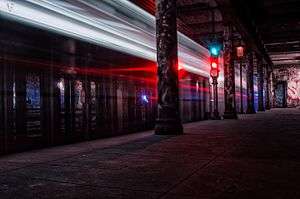91st Street (IRT Broadway–Seventh Avenue Line)
91st Street | |||
|---|---|---|---|
| Former New York City Subway station | |||
 | |||
| Station statistics | |||
| Address |
West 91st Street & Broadway New York, NY 10025 | ||
| Borough | Manhattan | ||
| Locale | Upper West Side | ||
| Coordinates | 40°47′29″N 73°58′27″W / 40.7914°N 73.9741°WCoordinates: 40°47′29″N 73°58′27″W / 40.7914°N 73.9741°W | ||
| Division | A (IRT) | ||
| Line | IRT Broadway–Seventh Avenue Line | ||
| Services | None (abandoned) | ||
| Structure | Underground | ||
| Platforms | 2 side platforms | ||
| Tracks | 4 | ||
| Other information | |||
| Opened | October 27, 1904[1] | ||
| Closed | February 2, 1959 | ||
| Station succession | |||
| Next north | 96th Street | ||
| Next south | 86th Street | ||
| |||
| |||
91st Street was a local station on the IRT Broadway–Seventh Avenue Line of the New York City Subway, located at 91st Street and Broadway in the Upper West Side of Manhattan. The station opened on October 27, 1904 as part of the first IRT line. It closed on February 2, 1959 due to its proximity to the 96th Street station, whose platforms had been lengthened southward toward the 91st Street station.
History
Operation of the first subway began on October 27, 1904, with the opening of all stations from City Hall to 145th Street on the West Side Branch.[2] A station was provided at 91st Street to avoid having 10 blocks without a subway station (86th Street to 96th Street).
The station's decline commenced in the late 1940s when platforms on the IRT Broadway–Seventh Avenue Line from 103rd Street to 238th Street were lengthened to 514 feet (157 m) to allow trains of ten 51.4-foot-long (15.7 m) cars to stop at these stations; previously, platforms could only accommodate six-car local trains. The platform extensions were opened in stages through 1948.[3][4] Furthermore, a new service pattern was implemented on the line during peak hours in the late 1950s, removing a rush-hour service bottleneck north of 96th Street by rerouting local trains up the Broadway–Seventh Avenue Line to Van Cortlandt Park–242nd Street and express trains to the Bronx and 145th Street via the IRT Lenox Avenue Line. On February 6, 1959, all Broadway trains became locals and all Lenox Avenue trains were expresses, eliminating the need to switch tracks.[5][6][7]
The rush-hour service could not be implemented until the platform extensions at stations on the line were completed. The original IRT stations north of Times Square could only fit five- or six-car trains. By 1958, the platform extensions at the local stations were nearly completed, but there were more problems with the platform extensions at the two express stations, 72nd Street and 96th Street. At 72nd Street, the track layout was simply changed, but at 96th Street, the local tracks and the outside walls had to be moved. A new mezzanine with stairways to the street was built between West 93rd Street and West 94th Street. The 86th Street and 96th Street stations had their platforms extended in order to accommodate 10-car trains. The 91st Street station could not have its platforms extended, because they would already be too close to the other two stations. It was closed on February 2, 1959.[8][9][10] Advertisements from 1959 persisted for several years before the station walls were graffitied over.[10]
Station layout
| G | - | Street Level |
| P Platform Level |
Side platform, not in service | |
| Northbound local | ← | |
| Northbound express | ← | |
| Southbound express | → | |
| Southbound local | → | |
| Side platform, not in service | ||
The station's two abandoned side platforms are still visible from passing trains. The 91st Street station is fairly well preserved, with the exception of some litter and graffiti.
See also
References
- ↑ "Our Subway Open: 150,000 Try It". The New York Times. October 28, 1904 – via nycsubway.org.
- ↑ James Blaine Walker, Fifty Years of Rapid Transit, 1864-1917, published 1918, pp. 162-191
- ↑ Report for the three and one-half years ending June 30, 1949. New York City Board of Transportation. 1949.
- ↑ "MORE LONG PLATFORMS; Five Subway Stations on IRT to Accommodate 10-Car Trains". The New York Times. 1948-07-10. ISSN 0362-4331. Retrieved 2016-03-27.
- ↑ "New Hi-Speed Locals 1959 New York City Transit Authority". Flickr - Photo Sharing!. Retrieved 2016-06-15.
- ↑ "WAGNER PRAISES MODERNIZED IRT; Mayor and Transit Authority Are Hailed as West Side Changes Take Effect" (PDF). query.nytimes.com. Retrieved 2016-06-15.
- ↑ "MODERNIZED IRT TO BOW 0N FEB. 6; West Side Line to Eliminate Bottleneck at 96th Street MODERNIZED IRT TO BOW ON FEB. 6" (PDF). query.nytimes.com. Retrieved 2016-06-15.
- ↑ Aciman, Andre (1999-01-08). "MY MANHATTAN; Next Stop: Subway's Past". The New York Times. ISSN 0362-4331. Retrieved 2016-08-26.
- ↑ "High-Speed Broadway Local Service Began in 1959". The Bulletin. New York Division, Electric Railroaders' Association. 52 (2). February 2009. Retrieved August 26, 2016 – via Issu.
- 1 2 Raanan Geberer. "The Ghost Subway Station on 91st". StrausMedia. Retrieved September 11, 2016.
External links
| Wikimedia Commons has media related to 91st Street (IRT Broadway – Seventh Avenue Line). |
- Abandoned Stations – 91 St
- nycsubway.org – IRT West Side Line: 91st Street
- A site with a historic 91st Street photo
- The Subway Station, a short story by Chananya Weissman, set at this station.
- Forgotten NY – Original 28 Subway Stations (small statement only)



